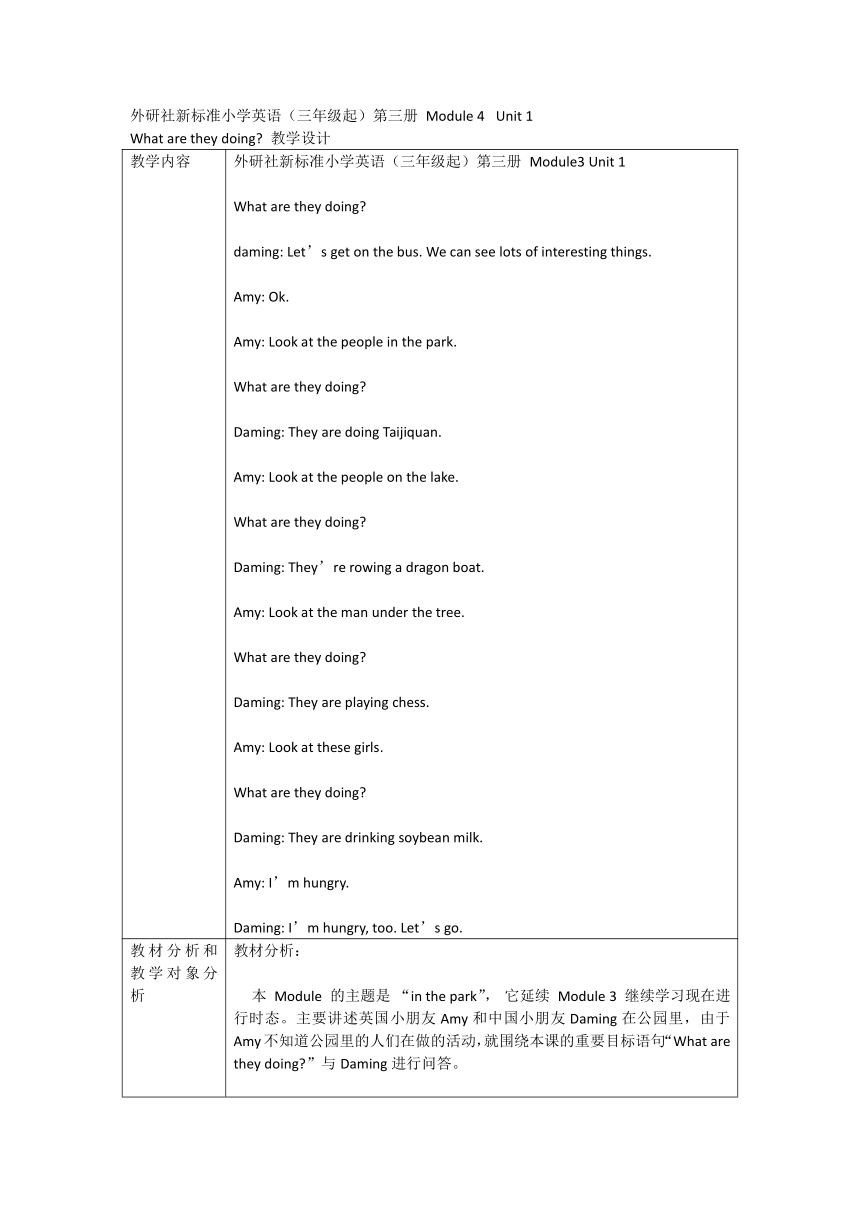
外研社新标准小学英语(三年级起)第三册 Module 4 Unit 1 What are they doing 教学设计 教学内容 外研社新标准小学英语(三年级起)第三册 Module3 Unit 1 What are they doing daming: Let’s get on the bus. We can see lots of interesting things. Amy: Ok. Amy: Look at the people in the park. What are they doing Daming: They are doing Taijiquan. Amy: Look at the people on the lake. What are they doing Daming: They’re rowing a dragon boat. Amy: Look at the man under the tree. What are they doing Daming: They are playing chess. Amy: Look at these girls. What are they doing Daming: They are drinking soybean milk. Amy: I’m hungry. Daming: I’m hungry, too. Let’s go. 教材分析和教学对象分析 教材分析: 本 Module 的主题是 “in the park”, 它延续 Module 3 继续学习现在进行时态。主要讲述英国小朋友Amy和中国小朋友Daming在公园里,由于Amy不知道公园里的人们在做的活动,就围绕本课的重要目标语句“What are they doing ”与Daming进行问答。 教学对象分析: 学生在前面一个模块已经学会了 “He’s doing... 及She’s doing...” 的表达, 所以我在设计这一课时,以What’s he doing 引出本课的重要目标语句What are they doing 以旧带新,让学生在复习中学习。 教学设计理念 本课主要借助多媒体课件创设比较真实的情境,让学生在真实的情景中习得语言和运用语言。 教学目标 知识与技能 1.知识目标:学生能够认读掌握本模块非动词: let's,interesting,thing,people,park,lake,boat,men,chesshungry. 动词:row,drink,jump,swim,run,cycle.及其现在分词形式。 短语:get on, lots of, look at. 2.技能目标:能在不明白动作行为时口头运用What are they doing 这类语句进行询问,并能口头运用They're doing taijiquan.这类语句说明自己对正在发生事情的判断。 过程与方法 通过多媒体课件创设情境,在情境中呈现本课新单词和新句型,单词句型融合教学。最后,也是通过教学课件利用图片拓展操练本课的功能目标语句。 情感、态度、价值 在文化意识上加深对中国传统体育文化的了解。 教学重点、难点 (1) 动词row,drink,jump,swim,run,cycle.及其现在分词形式。 (2)能在不明白动作行为时口头运用What are they doing 这类语句进行询问,并能口头运用They're doing taijiquan.这类语句说明自己对正在发生事情的判断。 教学方法 直观教学法、TPR教学法 教学准备 多媒体课件,单词卡片,录音机和磁带等。 教学过程 Step1 Warm-up.(热身活动) 1.Greetings. 2.Evaluation. T: Boys and girls, look here. I’ll divide you into two groups. This lake is for the girls. That lake is for the boys. If you do a good job, I’ll give you a boat. Let’s see how many boats you have on your lake. Let’s begin. 3.Sing a song. (I'm listening to music.) Step2 Presentation.(呈现活动) 1、教学课件呈现新单词: (park, let's, get on, lots of, people, interesting, thing.) T: Guess, where is it T: It's people park. T: Do you want to go to people park T: Ok, Let's go to the park. Look, the bus is coming, let's get on the bus. T: Now, we’ve in the park. What can you see in the park (We can see lots of trees. We can see lots of flowers. We can see lots of people.) (比较讲解people.泛指人,人们。通常当复数使用) T: In the park, we can see lots of interesting things. (新授interesting, thing. 讲解things.) Practice (以单词卡片 ... ...
~~ 您好,已阅读到文档的结尾了 ~~

